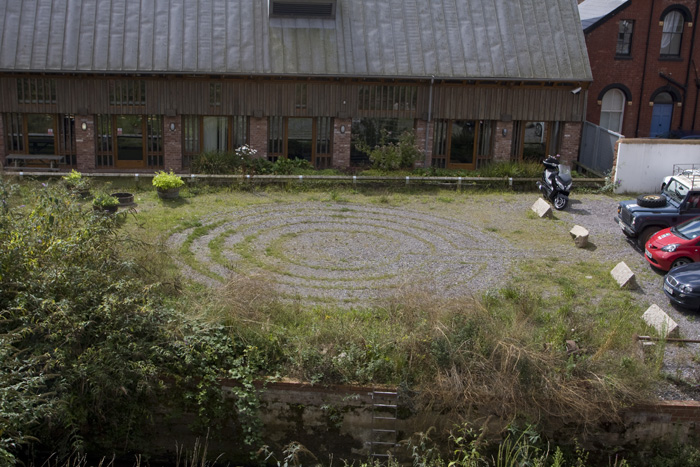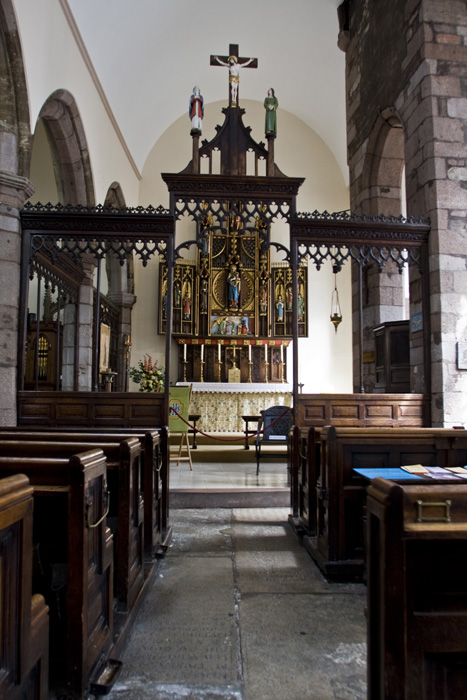It all begins with a view of my parents town of Lympstone.
Running up the center is the main throughfare of town, known as ‘The Strand’, with The Swan Pub on the right and the only store in town in the bottom left corner.

The train drops us day trippers off at Exeter Central station after a twenty minute ride from Lympstone, and I walk through the center of town. There has been some work since the last time I was here. Now the 2000 year old Roman walls stand next to a modern glass and steel shopping center.

Or in front of apartment balconies.

Also in the center of town is Exeter Cathedral, in which sits a statue of someone who was really good -and had a fabulous beard- sometime in the 16th century.

And a few other good people carved into the side of the church.

And a door, cuz, well, I like doors.

Don’t let the innocent look of this seagull fool you. While I was sitting on the stonewall surrounding the cathedral, this little monster dove over my shoulder and took a large chunk from my sandwich. It was even cannibalism, because I was eating –what was previously a wonderful- chicken and bacon sandwich. The seagull didn’t even look guilty about eating chicken, but just stuck his head back and swallowed it whole.
Then the little monster had the gall to pace back and forth in front of me, waiting for another tidbit. Until forsaking me for the new sandwich eaters to my right.

Away from the center off town, down towards the River Exe. On the left is the remains of the ancient bridge and church. An offshoot of the Exe once ran under this bridge, heading towards the mills.

Another view of the chapel and the bridge.

Gotta love a King who hides under a bridge, and still gets churches named after him. Or maybe it was the beautiful British sarcastic wit that told them to name churches on bridges after him. A permanent memory of his cowardess.

Kind Edmund gained the throne in 855, eventually he fought the Danes and someone called Ivar the Boneless. Which is just a beautiful name.

Modern bridge over the River Exe, with reflections from the bright blue sky.

A swan on the Exe.

Where the water channel that once ran under the abandoned bridge and through the mills, exits back into the Exe.

Once upon a time, Exeter was a walled city on the bluff over-looking the river. Down beside the river was marshland. The first mill on this marshland was built around 1220 by a Nicholas Gervase, who also built Exeter’s first stone bridge, which is the same one that is pictured above.
Channels were dug in the soft land to run bypasses of the river to run through the mills that dotted this area. The height of these mills was in the 1700’s when Exeter was the center of the woolen trade of the southwest. But the rise of steam power in the 1800’s put the water wheel mills in decline.
Up until the 1960’s and 70’s the mill was still being used for grinding, but now with diesel engines.
Finally it was sold and ended up being used by squatters before being partially burned in 1990.
The Devon Wildlife Trust bought the building and finished restoration in 2007.
One of the waterwheels built in 1895.

My tour guide telling me about this single room, which was in fact the only room in the tour. The large water wheel (pictured above) spun off to the left, turning the upright wheel on the left, thus turning the large horizontal wheel in the center.

finally turning the Stone Nut. All the power went through the stone nut to turn the grinding wheels. And it could be moved up and down to engage and disengage the grinding stone. Thus I know where the technology came from to build the gearbox of my MG.

In front of the Mill –which is known as the Cricklepit Mill- is the garden, and in this garden is a recently built labyrinth from a traditional design. My favorite part are the stones that are used to keep the cars from driving on the labyrinth, are the old mill grinding stones.

But before I continue my wanderings about Exeter, I would like to quote the guide book for the mill:
Spooky goings-on
During the 1990’s Cricklepit Mill was used as a furniture shop and its wheel machinery was left derelict. One day, with no warning, it suddenly began to turn, driving all of the gearing in the building, and causing the owner’s hair to stand on end!
I think it’s the explanation point that makes my love the story so much.
As I took a different route back to the center of town, there was a beautiful leaning Victorian building. The shop on the bottom floor sold wedding dresses.

Across the street is a Free Book Store.
There is really nothing better than a free book store,
Except, of course, a free book store in a building like this.
(I apologize for the ugly American car in front.)

It is called Book Cycle, where the customer decides the prices for the books, and the proceeds, and books, are send to far away countries to help with literacy. I found myself Terry Pratchett’s Guards Guards and Malcolm Lowry’s Under the Volcano. And of course made a donation to the cause that was larger than two used books would have cost. But how do you say no to idealistic girls like this:

Back up toward town, there was a small church with a beautiful carving on the outside. I stopped to take a picture, and quickly realized that the photograph, -gotta love my wide angle lens- of the man pausing for a moment for me to click the shutter was a much better picture than the stone carvings.

The floor of the church, between the pews, with a grave marker for 1671.

And the altar, with more grave markers as flagstones.

And finally, at Exeter Central train station, there is an advertisement, with one of those pioneering rock stars, who you would never have thought they would sell out.
And just because it’s England, a CCTV camera.

